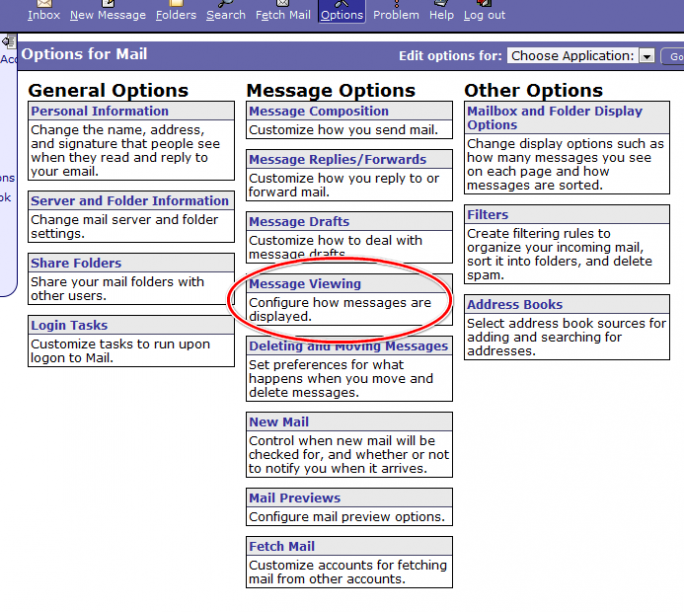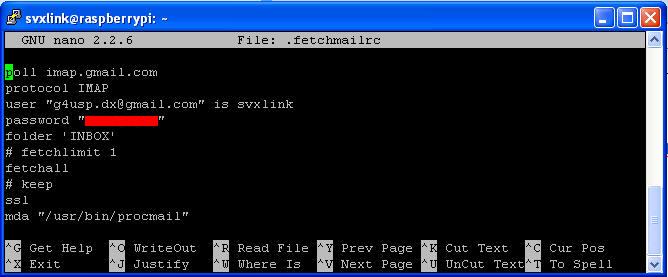Fetchmail For Windows Download

Fetchmail For Windows Download 7

The fetchmail program is a classic UNIX and Unix-like utility used to retrieve email from remote servers and deliver it to local users on a server. There are a number of different scenarios where fetchmail is used.
Fetchmail is a popular tool for manually downloading email from a POP or IMAP server for personal use on a local machine. Another common application uses fetchmail to create an “email gateway,” where email is collected from a number of different accounts or from a large centralized server and provided to the user in a manageable situation.If you’re new to Linode we always recommend completing our before beginning a tutorial. If you’re new to Linux we also recommend considering the and the many documents in the section. If you need a more full featured email stack, consider one of our other. Installing FetchmailFetchmail must be installed on whatever computer you need to download mail to.
This document is applicable for users of desktop Linux who need to download email from their Linodes and users who need to download email to their Linodes from external sources. 123456poll mail.example.com protocol pop3:username 'admin' password 'dir3cti0n' is 'username' here;username 'fore' password '0rd3r' is 'foreman' here;poll mail.example.org protocol pop3 with option sslproto ':user 'betty' password 'p1nk' mda '/usr/bin/procmail -d%T': user 'betty' password 'p1nk' mda '/usr/bin/procmail -d%T'In the first specification, fetchmail is told to check the mail.example.com server, using the POP3 protocol, for the users admin and fore.” Also, the “ is 'username' here; directive is used to clarify the relationship between a remote user (i.e. Admin and fore) and users on the local machine (i.e. Username and foreman).In the second example, a single account (i.e. Betty) is retrieved from the remote server (i.e. Mail.dexample.org) and passed to the MDA procmail utility. Additionally, account has the sslproto option is enabled to encrypt this traffic using ssl.Fetchmail requires that the /.fetchmailrc file have the of 600.
Permissions of 600 equate to read and writeable by the user account which “owns” the file with no permissions granted to group or other users. To achieve this, issue the following command: chmod 600 /.fetchmailrcUsing Special Syntaxes for Additional ClarityFetchmail provides a number of syntactic niceties in an effort to make.fetchmailrc files easier to read. For instance, the words and, with, has, wants, and options are ignored by fetchmail. Additionally, the punctuation characters:,;, and, are ignored when fetchmail reads the configuration file.While it is possible to specify credentials for a server on one line, more often configurations are specified over a number of different lines. Fetchmail is insensitive to whitespace except when it occurs in quoted strings, although in these circumstances it’s possible to escape carriage return characters with backslashes. All characters following a # character on any given line are considered comments and ignored by fetchmail.Entries for new servers begin with the word poll.
How to install & configure getmail, replacement of Fetchmail utitity? Getmail: G etmail is a mail retriever designed to allow you to get your mail from one or more mail accounts on various mail servers to your local machine for reading with a minimum of fuss. Getmail is designed to be secure, flexible, reliable, and easy-to-use. Getmail is designed to replace other mail retrievers such as. So I'm still going to try i.Scribe, but it only supports one mail account. And since I have three, I've got a problem there (unless I buy InScribe, but I see no point if there is a free alternative). Hence the reason why I would love a Windows port of Fetchmail, but I can't find one.
Fetchmail will check all “poll” entries for new mail every time it runs. You can specify server entries with the work skip and cause fetchmail to ignore these entries unless they are specified on the command line. This skip functionality is intended make it easy to disable checking mail servers that have gone off line or for testing purposes.
123set daemon seconds set postmaster 'username' set logfile '/logs/fetchmail.log' set syslogThe following sections will explain the functionality of these settings. Daemon ModeThe daemon setting with an interval specification (in seconds,) will cause fetchmail to daemonize itself and run as a background service. In this mode, each mail server will be polled on the interval specified.
If you need to poll from different accounts with different frequencies you can specify the interval $NUM where $NUM is the number of intervals. Consider the following excerpt.fetchmailrc. 1234567set daemon 60poll mail.example.com protocol pop3 with option interval 3:user 'admin' password 'r00t' mda '/usr/bin/procmail -d%T'poll mail.example.org protocol pop3 with option ssl, interval 20:user 'feedback' password 'h3ck1e' mda '/usr/bin/procmail -d%T'In this example the daemon is set to run every 60 seconds. Fetchmail is set to poll the example.com server every second interval, or every three minutes. At the same time, the example.org account will be polled every 20 intervals, or once every twenty minutes. PostmasterThe set postmaster option allows you to configure where otherwise undeliverable will be delivered.
Given the following example.fetchmailrc. 123456set postmaster 'username'poll email.example.com protocol pop3:username 'username' password 'dir3cti0n';username 'fore' password '0rd3r';username 'gigs' password 'p@rty';Assuming that there are system user accounts for username and fore, mail downloaded from these accounts will be deposited in /var/mail/username and /var/mail/fore respectively. However, if there is no system account for a gigs user this mail would be deposited in the username user’s mail spool (i.e.
/var/mail/username) because the username user is set as the postmaster for this fetchmail session. LoggingWhen invoked from the command line, fetchmail generates output regarding its activities to standard out. If this is undesirable behavior you can use the logging directives to specify an alternate record keeping behavior. Let us consider the following directives.fetchmailrc. 1set syslog set logfile '/logs/fetchmail.log'The first directive tells fetchmail to store all logging information in the system log. The location of this log may vary depending on your system configuration, but is typically located in /var/log/mail.log. The logfile directive allows the user to specify a file in which to store logging information.
In this example logs are kept in the logs/ directory and fetchmail.log of the user’s home directory for the user account that executes fetchmail. Additional Fetchmail FunctionalityThis document has only covered a minimal subset of fetcmhail’s functionality. Indeed fetchmail is renowned for its extreme flexibility and versatility. This section will provide an overview of this functionality. Alternate Mail ProtocolsTypically, fetchmail is used to retrieve email from POP3 mailboxes; however, it also contains support for alternate protocols. Supported protocols include IMAP, POP3 with Kerberos, and ESTMTP. Example syntax for displaying alternate protocols is as follows.fetchmailrc.
12345678poll email.example.com protocol imap:username 'username' password 'dir3cti0n';poll mail.example.org protocol kpop:username 'fore' password '0rd3r';poll email.example.net protocol etrn:username 'gigs' password 'p@rty';poll mail.example.info protocol auto:username 'gigs' password 'p@rty';Fetchmail is able to deduce which variant of the IMAP protocol is used. Premium tech tool guided diagnostics labs inc. The KPOP option forces fetchmail to authenticate to a POP3 protocol with Kerberos V4 authentication on port 1109.

The ETRN option allows fetchmail to receive email with the ESMTP protocol. You can also specify auto as a protocol option. In this case, fetchmail will try to determine which protocol your server supports when connecting. Alternate Methods for AuthenticationFetchmail provides a number of alternate options for authenticating to your mail server, if you are uncomfortable storing your passwords in your.fetchmailrc file. First, fetchmail will look in a /.netrc file for log in credentials, before prompting for passwords on the command line. An example.netrc file is as follows.netrc.
123456789machine email.example.comlogin usernamepassword d1r3ct1onmachine mail.example.orglogin jeffpassword d@nc3machine mail.example.netlogin gigsp@RFI3sThe ftp UNIX utility also uses the.netrc file, so you can use this feature to avoid duplicating. If usernames are not provided in a.netrc file or in.fetchmailrc, fetchmail will try to connect to the remote server using the current user’s username on the local system to connect to the remote server. The fetchmail program accepts alternate usernames with the -u option. This command takes the following syntax: fetchmail -u username example.comIn this example, fetchmail will connect with the username username to the server at example.com. All of these authentication options, including specifying credentials in the.fetchmailrc will allow fetchmail to successfully retrieve email.
However, in contemporary deployments, specifying usernames and passwords in the.fetchmailrc file is the most popular and efficient option by far. Workflows with FetchmailThe deployment profile of programs like fetchmail has changed a great deal in recent history. Where once users needed a program like fetchmail to retrieve email from their Internet service providers, it is now very plausible to run your own fully fledged email server. Fetchmail also predates the development and proliferation of web-based email and “Email as a Service” providers like Fastmail.fm and Google’s Gmail offerings.Nevertheless, programs like fetchmail remain useful in some contexts. Fetchmail is often used to retrieve email from email service providers and download this data to users’ local machines. Other users deploy fetchmail as part of scripts or running in daemon mode to deliver mail to a small private IMAP service, for example. This makes it possible to access mail that is delivered to multiple addresses that are not hosted on the email gateway.
Fetchmail makes it possible to centralize and collect email from a number of different sources into a single manageable archive, without needing to control the configuration and routing of mail on those remote servers. In this way, fetchmail remains a valuable and useful tool. More InformationYou may wish to consult the following resources for additional information on this topic.
While these are provided in the hope that they will be useful, please note that we cannot vouch for the accuracy or timeliness of externally hosted materials.Join our Community.
Configuration Informationcat /.fetchmailrc pass;mda '/usr/bin/procmail -f%F -d%T';EOFchmod -v 0600 /.fetchmailrcThis is an example configuration that should suffice for mostpeople. You can add as many users and servers as you need usingthe same syntax.man fetchmail: Lookfor the section near the bottom named CONFIGURATION EXAMPLES. It gives somequick examples.
There are countless other configuration optionsonce you get used to it.